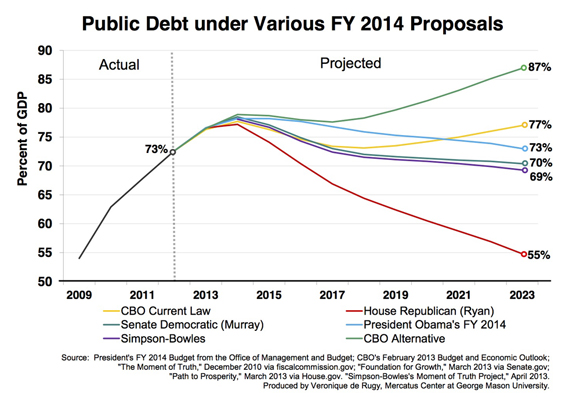- | Government Spending Government Spending
- | Data Visualizations Data Visualizations
- |
Public Debt Under Various FY 2014 Proposals
The recent release of budget plans for fiscal year 2014 makes a proper perspective of projections of public debt even more important. This week’s chart shows the debt held by the public as a percentage of the gross domestic product (GDP) under various budget proposals.
The president and numerous politicians claim that the United States does not have an immediate crisis in terms of debt. The president has gone so far as to say, "In fact, for the next 10 years, it's gonna be in a sustainable place."
The recent release of budget plans for fiscal year 2014 makes a proper perspective of projections of public debt even more important. This week’s chart shows the debt held by the public as a percentage of the gross domestic product (GDP) under various budget proposals.
Debt would end up equaling 73 percent of GDP by 2023 under the president’s plan. Projected debt under the Senate Democratic plan is only three percentage points below the president’s at 70 percent of GDP (blue lines). That figure nearly aligns with the Simpson-Bowles’s bipartisan plan (purple line), which projects debt at 69 percent of GDP, and stands substantially higher than the 55 percent target of the House Republican budget (red line).
The CBO projects that debt will equal 77 percent of GDP in 2023 under current law (orange line)—far above any of the budget plans. Changes to these laws, such as removing spending cuts from sequestration, will result in debt held by the public soaring to 87 percent of GDP by the end of 2023, as shown in the CBO alternative scenario (green line).
It’s hard to see how any of these budget plans represent a serious attempt to cut the debt, as most of the plans only leave us where we are today, if not worse off. Even the Ryan plan, which promises a 55 percent debt-to-GDP level by 2023, rests on optimistic GDP growth and revenue projections while failing to fully address the unsustainability of the current entitlement programs. The Ryan plan repeals Obama's health care law, but it pushes off urgent Medicare reforms until 2024 and leaves Social Security untouched.
These plans prove that Washington lacks the commitment necessary to address the true drivers of the debt: spending for entitlement programs and interest costs on the debt itself.


